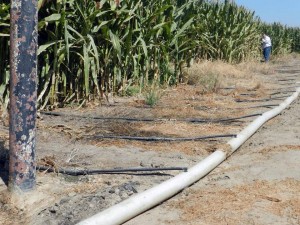
By Peter King
A sprawl of sewage treatment plants, recharge basins and desalination facilities, stretching out across an industrial backlot near Rancho Cucamonga.
A collection of slender, solar-powered telemetry towers rising from an almond orchard in the San Joaquin Valley to bring high-tech efficiency to irrigation.
And, at a university research station near Irvine, three Potemkin Village-like suburban houses in a row, offering a new vision of the traditional lawn.
Mindful that only nature can whip a drought, those who study and manage water in California are focused not on the current epic, but on better preparing the state for the next drought, and the drought after that, and the drought after that.
The desalination plants, the lawn-less yards and the tech-savvy approach to irrigation are just a few examples of that new water-saving landscape. Gone will be the massive projects once erected to battle water shortages. In their place will be a host of incremental measures, each designed to do more with what nature provides.
The environmental toll and political challenges associated with “moving the rain,” as the Shasta Dam’s purpose was once described by a hardhat working on the project, will require solutions that appear to be more like buckshot than the silver bullets of the past.
Peter Brostrom, a state Department of Water Resources official responsible for finding water efficiencies, talks about taking “a variety of small steps across the board,” such as thinning overgrown forests, shoring up leaky delivery systems and building more coherent and uniform data about water supply and usage.
Randy Fiorini, a third-generation Turlock grower who serves as chair of the Delta Stewardship Council, says it’s time to move on from waiting for Shasta-scaled water storage projects that once were the Holy Grail of California agriculture, but have become increasingly politically problematic. Instead, he advocates a push for smaller, less controversial reservoir projects backed by “local champions.”
“There are a lot of smaller projects on the drawing boards around the state,” he has written, “and we could actually get many of them built in the near future.”
Whatever individual measures are pursued, everyone understands the most opportune time to gain ground is now: When a drought ends, and they all eventually do, the rains wash away the general urgency and intensified focus on all things water.
“One way to put it is that you try to get as much as you can out of a drought,” said Martha Davis, who in the 1970s helped lead a movement that both saved Mono Lake and introduced Los Angeles to low-flow toilets.
“Another way to think about it,” she said from her office at the Inland Empire Utilities Agency in Chino, “is that a drought pushes us and shows where we are not prepared, and also shows us what is working in one place, and what may work in other places.”
Californians today consume roughly a quarter less water per capita than they did two decades ago, while irrigation innovations have allowed growers to achieve greater crop yields without additional water — progress that was prodded along by three previous droughts.
Among the more optimistic water thinkers, there’s hope that the severity of the current epic might fundamentally alter how Californians use and think about water. It is a transformation, they say, that will become more a matter of necessity than nobility as population growth and climate change influence the supply-and-demand equation.
“If California is going to have 50 million people,” Gov. Jerry Brown has said, “they’re not going to live the same way the native people lived, much less the way people do today. … You have to find a more elegant way of relating to material things. You have to use them with greater sensitivity and sophistication.”
At the Inland Empire Utilities Agency, new thinking about its water portfolio began about 15 years ago.
It laid the infrastructure for large-scale recycling projects, including the world’s largest indoor composting facility, situated in a former Ikea warehouse. It retooled flood control systems to capture rain runoff for underground storage, rather than rush it out to the Pacific. It deployed de-salters to clean underground water polluted by runoff from dairies and steel plants. It put in programs to encourage native landscapes.
It has been expensive: an estimated $500 million. But it also has been effective. Overall, locally developed water supplies have risen by 50% and the agency’s reliance on imported water has fallen by 40%.
“Hopefully we are building a sustainable system to get us through the next 100 years,” said Joe Grindstaff, general manager of the agency that supplies wholesale water for 830,000 residents in seven municipalities.
Of course, meaningful progress must involve the sector where the bulk of California’s developed water is put to work: farms.
Some agricultural leaders make the case that forces of change already have begun to influence practices in the state’s growing regions, particularly in the San Joaquin and Sacramento valleys.
One is economic. The trend has been to plant more trees and vines and far fewer forage crops such as alfalfa. Fruits and nuts are more lucrative — the dollar value of the California agricultural economy has doubled in two decades — but they are also multiyear investments that require reliable sources of water.
At the same time, the go-to source for water in droughts — underground reserves — is becoming harder to get to. As water tables drop, the price of pumping goes up. And in any case, the state’s recently enacted Sustainable Groundwater Management Act means a new sheriff is coming to town.
Full implementation of the act is a good two decades away; local agencies must first develop plans to replenish and manage underground supplies to make them sustainable for the long haul. As the plans evolve into action, it is widely believed that the result in some farming regions will be that significant acreage will be taken out of production.
Meanwhile, it is expected that market forces eventually will work to place a higher premium on agricultural water.
“Economists have for years argued that the market should determine the value of water,” Dan Dooley, a water lawyer who helped draft the groundwater legislation, noted in a speech in April. “Instead the price for most water is determined almost exclusively by the cost of the infrastructure to deliver it to the customer, not by the value of water itself.”
California growers, he said, “increasingly see water as an asset. … This change in how water is viewed will also alter how water is managed.”
For starters, it will make efficiencies even more attractive, especially to younger generations who grew up in an era of heightened environmental awareness and increased access to technological advances.
Jeff Shields, general manager of the South San Joaquin Irrigation District, cites one example: a young man who visited the district’s Manteca office and was struck by the inefficiency of flood irrigation and high-volume sprinklers.
“He was just out of Fresno State, and he came to me and said, ‘Really? This is how we are still irrigating? A guy in a truck opens up a gate and lets the water go and comes back in five hours and closes the gate. That’s the best we can do?'”
From that encounter came a pressurized water system, powered by solar and high-efficiency motors, that feeds water on demand to farmers’ drip irrigation systems. Data relayed from towers arrayed within the orchards allow growers to determine from ground sensors when and how long to irrigate, and to order water delivery to their drip systems by computer or smartphone.
“They can be on a beach in Hawaii and take care of their irrigation,” Shields said. And use considerably less water in the process.
At present, the pilot project, now in its third growing season, involves just 3,000 of the district’s 50,000 acres. But, Shields said, it has the capacity to be employed more broadly: “It’s scalable, absolutely it’s scalable.”
What flood irrigation is to agriculture, the front yard is fast becoming to the residential sector. Landscaping accounts for half of urban water use in California, running as high as 80% in some localities.
And so, with mandatory conservation edicts, brown lawns and plastic turf have become emblems of this drought, just as bricks in toilets were during the 1970s drought. What’s not clear is whether the response will outlast the emergency and, more to the point, whether it represents an enduring transformation in the way residential Californians regard water.
“Old habits are hard to break,” said Jerry Brown, general manager of the Contra Costa Water District. “People have their ways, and I’m not sure society is ready to say a beautiful house doesn’t require a nice green lawn out front.”
Still, water consumption in the Contra Costa County district was down 40% in June from the same month in 2013.
Shifts do happen. A Los Angeles sky not choked with smog was once thought unimaginable. The state’s response to the energy crisis of 15 years ago also offers an instructive parallel. California entered the crisis facing the prospect of rolling blackouts and criticism of its failure to build more power plants. It emerged, after two years of double-digit conservation, with a fundamental shift in thinking and consumer behavior.
What the state needed was not additional generation capacity. What it needed was to manage demand, to conserve, during the 400 hours a year or so when supplies were potentially tight. It was a conversation-altering breakthrough.
“People always tend to focus on the supply side,” said Wally McGuire, primary architect of the state’s Flex Your Power conservation campaign. “But the demand side of the equation is equally powerful.”
Flex Your Power lives on today as Flex Alert, which calls on Californians to move into conservation mode when supplies tighten. In the few times Flex Alert has been activated, the response has matched or bettered that seen in the energy crisis.
“People are generally good” is how McGuire described the driving premise behind Flex You Power, “and they will do the right thing.”
Movement toward lasting change is easier when the destination can be visualized. At the University of California agricultural research center in Irvine, an 8-year-old demonstration project shows how alternative landscaping doesn’t have to be all cacti and lava rocks.
Three beige classrooms have been outfitted and landscaped to resemble a row of suburban homes, complete with white picket fences. They are not-so-poetically identified as residences A, B and C. A offers conventional landscaping: fescue lawn, birch trees and boxwood. B’s plants and grasses are better suited to a Mediterranean climate. C’s are natives: sedge grasses, manzanita and sycamores.
All three seem fetching enough. The difference is that B requires about half as much water as A, and C even less.
Tammy Majcherek, a UC community educator, said requests from municipal landscapers and private gardeners to tour the project have picked up as the drought persists.
“I am not sure the old mindset has changed,” she said, “but I think maybe we are beginning to turn the corner.”
Link to article







